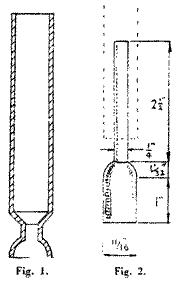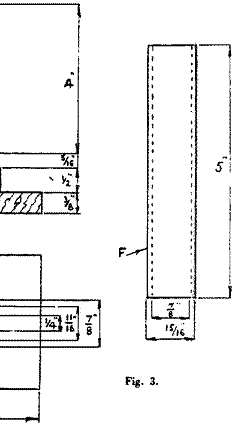|
|
|
|||
|
|
||||
|
|
||||
| Plan: Sparey's Rocket Plane | ||||
|
|
HOME | SITE MAP | FORUM | CONTACT |
|
||
|
ABOUT | MOTORS | MODELS | ARCHIVE | HISTORY | STORE | FAQ | LINKS
|
|
|
|
|
|
||||||||||||||
|
Sparey's Rocket Exploits
The following account of Laurence Sparey’s exploits with rocket planes and rocket fuel is extracted from the June 1999 issue of SAM 35 Speaks (pp. 54-55). Information in that article was in turn taken from the 'Model Aircraft' section of the 1944 issues of the Percival Marshall weekly publication Model Engineer. [In the July 1944 issue], Sparey has plans for a “new” model, unusually graceful and well-proportioned. This is because it is based on a German rocket model of 1936 [Ed.: This is undoubtedly the Haase Rocket Plane, depicted by Frank Zaic in his Model Aeronautic Handbook of 1944]. In discussing the model Sparey doesn't make it clear whether he is talking about the German model or his own, or when the flights of the latter happened, if at all. He mentions liability to damage and the erratic behaviour of the rockets but this could be about the German original. It is clear that our author was interested in rocket flights at that time and gathered information on rocket fuel but whether he built and flew such models is doubtful. Sparey seemed to think the model resembles what he calls the “doodlebugs”, which had only just arrived over his head, in spite of the model's power unit being below the wing. The hollow aperture for the rocket is The length of the hole is governed by getting the whole of the model balanced on the C.G. which he places at 50% of the chord. As with so many of his designs, he has no means of altering incidences, so sliding the rocket is the only trimming device. Sparey says the machine would have to be propped up for launching but even here it is unclear whether he has gone through the procedure himself. |
|
||||||||||||||
|
|
|
|||

|
|
|||

Sparey gives the following mix, emphasising that all ingredients be dry and well sieved:- Saltpetre - 6 parts: Charcoal - 3 parts: Sulphur - 2 parts. One wonders if any reader was foolish enough to try this during the war. Percival Marshall was [a] big enough firm to afford legal eyes looking over their print: they must have been “down the shelters” when this piece passed through the office! |
|

- SAM 35 Speaks, June 1999 (p. 55)
|
||
|
In the August 1999 issue of SAM 35 Speaks (pp. 41-43), Doug McHard provided a sequel to Sparey’s exploits with an account of how Sparey had inspired him to conduct his own youthful experiments with home-made rockets and rocket planes, under the heading ‘SHEFFIELD'S SECRET WEAPONS FACTORY’: |
|
|||
|
In the June issue of ‘Speaks’, you question whether any reader of Model Engineer was foolish enough to try making rockets to Sparey's detailed instructions. The answer is ‘yes’ – at least one 15 year old Sheffield reader! I clearly remember collecting my weekly copy of M.E. from the newsagents near to the College of Arts and Crafts, and after school being absolutely desperate to get home by the fastest possible tram in order to get cracking on Sparey’s rocket-making gear. It was a Friday, and early the following morning, with the ME in hand, I hurried down to our local chemist and actually asked for the Saltpetre, Sulphur and Charcoal over the counter! The lady chemist was not a bit phased (imagine doing it today) and she obligingly supplied me with several ounces of each of the first 2 items, but pointed out that they didn’t sell charcoal. She suggested the art shop close by but thought that the quantity I needed might be rather expensive. So she gave me instructions on how to make my own, by putting strips of wood in a tin can and completely covering it with dry sand before heating it over the gas ring until it stopped smoking. Back home, I tried the process using bits of firewood and lo and behold it worked perfectly; I soon had a good supply of charcoal and mother had a very smelly kitchen but thought it quite clever to be able to make one’s own charcoal – after all, we art students used the stuff to draw with didn't we? |
||||
|
At the time, I had an attic workshop – remote from prying eyes – and for the rest of the weekend it became a little Peenemunde. Without a lathe, the rocket making gear had to be hand-fabricated and my only brass tube was a bit bigger than Sparey's and so were my finished rockets. By Sunday evening I had three ready for testing and was desperate to try them out. I didn't want to try out my secret rockets in the yard, because it was fairly certain that the experiment would be forcibly curtailed. Fortunately, however, my attic had a skylight that could be jacked wide open and this seemed a good, well concealed launch site. The plan was to attach a long stick to the rocket à la Brocks and with this in a milk bottle, sticking out of my skylight, light the rocket, retire immediately as they say, and hope for the best. Dusk was falling by the time all was set up, and I remember being very excited at the prospect of a successful launch, and also just a bit apprehensive; sufficient for me to duck down behind my workbench after lighting the fuse. As I peeped over the top of the bench, the rocket eventually ignited and filled the room with acrid smoke before gathering enough thrust to leave the bottle. I dashed over to the window just in time to see my projectile completing its low trajectory, as it lodged – still emitting smoke and flames – in the roof guttering of a house across the road. I prayed for it to go out, but it seemed to burn for ever. In reality, it was no doubt quite a short time, but I had visions of the house catching fire and my being frog marched away by angry neighbours. Several people gathered in the street to look up at the little conflagration, but after it went out and following a few exchanged comments, they went on their way (Sheffielders after all, had become used to far more dramatic fire bombs from Germany). The rocketed householder remained blissfully unaware of his lucky escape but the rocket stick remained visible from my window for several weeks, until a mighty downpour eventually washed the burned-out remains into the downpipe from where, sometime later, there was an overflow, sufficient to require dismantling the pipe to clear it of backed-up debris lodged on top of a mysterious rocket wedged at a bend. The whole episode was, I confess, a bit scary and afterwards I realised how potentially dangerous it had been. The remaining two rockets were never launched, and I never made another Sparey rocket, mainly because it seemed unlikely that the things would generate enough power to lift a model into the air. This lack of power could have been due to several reasons. One point not mentioned in ‘Speaks’, was that Sparey’s rocket fuel instructions outlined the functions of its individual constituents, and I modified the proportions (as indeed Sparey encouraged the reader to do). Extra Saltpetre was supposed to “increase the rapidity of fire” – did this mean more thrust? Anyway, for me, it didn't quite work like that. |
|
|||
|
|
|
|||
Plan for Sparey's Rocket Plane
(A larger copy of the plan is also available to
view or download). |
||||
|
|
|
|||
|
|
|
|
|
|
|
|
Acknowledgements - Article and plan contributed by Peter Tolhurst |
|
|
|
|
ABOUT | MOTORS | MODELS | ARCHIVE | HISTORY | STORE | FAQ | LINKS |
|
|
Terms of Use
|
Queries? Corrections? Additions?
Please
contact us.
|
|